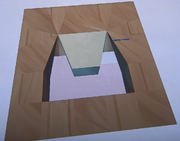- The official term for a voxel is now 'block,' to better describe a single unit of material in the default shape and default size (1 block) while using the add tool.
A Zero Volume Voxel, or ZVV is a rendered voxel with no volume. Most ZVVs are invisible when viewed from at least one angle, which can make them difficult to place. ZVVs can be of any material, including air.
Special ZVVs[]
Core[]This is a voxel whose eight corners are all at the exact center of a world voxel . This ZVV is also a Micro-Voxel, and behaves like one when placed. It is invisible from every angle. |
 Core ZVV |
Edge[]This ZVV has two of its corners at the center of each of four non-adjacent edges of a voxel. It takes the shape of a square and is invisible from one side. The image to the right shows both this voxel and the seamless intersection between voxels when placed in a surface. |
 Edge ZVV |
Side[]This is a voxel that has four of its corners at the center of one side of a world voxel and four of its corners at the center of the opposite side of the same world voxel. Like the Core ZVV it is invisible from every angle. |
 Side ZVV |
Applications[]
Stops Blending[]By carefully placing a side ZVV, you can stretch two voxels across an empty world voxel. Since the materials are not adjacent, the materials do not blend. |
 Stops Blending |
Inlaid Patterns[]When placed in a surface, the side and edge ZVVs form a pattern that is flush with the surface of ordinary voxels and with predictable angles. Notably the corners of the 3x3x1 volume formed by the Side ZVV in this picture are those needed to create a 45 degree angle. |
 ZVV Inlaid Patterns |
Sheets[]Like a Micro-Voxel , placing ZVVs near each other stretches them, but unlike normal Micro-Voxels, they produce widthless sheets. |
 ZVV Sheet |
Meeting Surfaces without Warping[]For example, Stepped arches that are difficult to create due to the voxels of each step warping the voxels in the next. Zero Volume Voxels can be used to make two voxels meet while still leaving a ZVV inbetween, allowing the surfaces to be placed independently of each other (video by Oedefe) |

